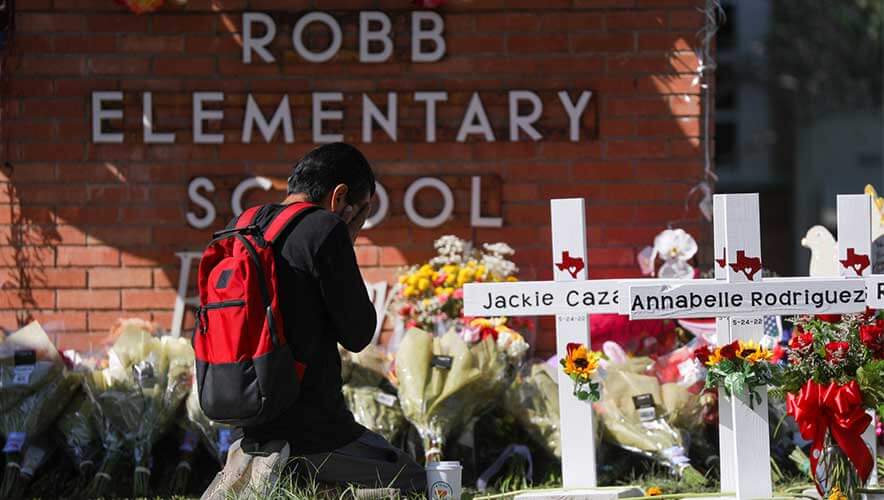DOJ Report Finds Law Enforcement Greatly Failed in Uvalde School Shooting Response
The U.S. Department of Justice published a report on 18 January concerning the 2022 school shooting at Robb Elementary School in Uvalde, Texas. The report determined that law enforcement was responsible for “cascading failures of leadership, decision-making, tactics, policy, and training” occurring prior to, during, and after the mass shooting that left 19 children and two teachers dead, along with 17 more people injured.
The shooting occurred in May 2022 when a gunman opened fire in the elementary school. Responding officers waited for more than an hour to confront the shooter.
“As a consequence of failed leadership, training, and policies, 33 students and three of their teachers—many of whom had been shot—were trapped in a room with an active shooter for over an hour as law enforcement officials remained outside,” said U.S. Attorney General Merrick Garland in a statement released with the report.
The report aimed to fully evaluate law enforcement’s response to the shooting, address any and all gaps or insufficiencies that the agencies might have in responding to a mass shooting, and honor the victims and survivors of the Uvalde shooting.
“The most significant failure was that responding officers should have immediately recognized the incident as an active shooter situation,” the report added. The nearly 600-page report detailed that law enforcement officers failed to focus and dedicate their efforts into entering the room the shooter was in, where victims already needed emergency medical attention.
“These efforts must be undertaken regardless of the equipment and personnel available to those first on the scene,” the report said. But instead, 77 minutes went by between when officers first arrived at the school and when they confronted and killed the gunman.
The report noted that the first responding officers did attempt to enter the classrooms the shooter was in, but they retreated when they were fired upon and “began treating the incident as a barricaded subject scenario and not as an active shooter situation.” This failure to act continued even after law enforcement heard gunshots almost an hour after the initial attack.
Throughout the report, a lack of coordination and communication was cited as an issue with tragic consequences, including failing to coordinate immediate entry into the classrooms. Instead, police waited for equipment and keys that were unnecessary to enter the rooms.
“None of the law enforcement leaders at the scene established an incident command structure to provide timely direction, control, and coordination to the overwhelming number of responders who arrived on the scene. This lack of structure contributed to confusion among responders about who was in charge of the response and how they could assist,” the report said.
On the communications front, one of the leading officers, Uvalde Consolidated Independent School District Police Chief Pete Arredondo, left behind his radios when he arrived at the school and later directed other officers to focus on removing victims from the school instead of entering the classrooms the shooter was in. Evacuating the rest of the school took nearly 45 minutes.
Arredondo was mentioned heavily throughout the report, which determined that he was the de facto incident leader on the scene and that he failed to “provide appropriate leadership, command, and control.”
“These failures may have been influenced by policy and training deficiencies,” the report said. Although many of the responding officers were trained for active shooter scenarios, others lacked any such training or incident command training—on top of everything, most officers from different agencies had never jointly trained together.
Even after victims were pulled out of the school, responding officers only provided “limited instruction and direction on where to proceed.” Once children were removed from the school, they were placed on school buses that took them to a reunification site—meaning some children who were injured did receive prompt medical screenings. One child who was shot in the leg had to walk out of the school without assistance, and other children with bullet wounds, cuts from shrapnel, and other injuries were boarded onto the buses and released to waiting family members without being triaged or screened for medical attention.
“As such, injured victims had delayed medical care and were at risk of further injury,” the report said. “Only those victims who were brought to the hospital were fully assessed.”
Other failures in communication were observed after the shooting, including conflicting instructions about the location of the reunification site and how next of kin were notified about a death, which the report described as “disorganized, chaotic, and at times no conducted in a trauma-informed manner.”
The chaos surrounding the reunification site possibly amplified the trauma the children experienced after hearing gunshots and screams, or witnessing friends, classmates, and teachers shot, according to the report. Several of the students and staff taken from the school were not reunited with their families for several hours.
Responders were also impacted by a lack of timely access to trauma and support services.
“For the hundreds of law enforcement, medical, behavioral health, and government personnel who responded to this incident, shared trauma can make what happened even more overwhelming. Law enforcement’s trauma is also exacerbated by the backlash from the community—as the community’s trauma is exacerbated by the lack of an adequate response from law enforcement,” the report said.











